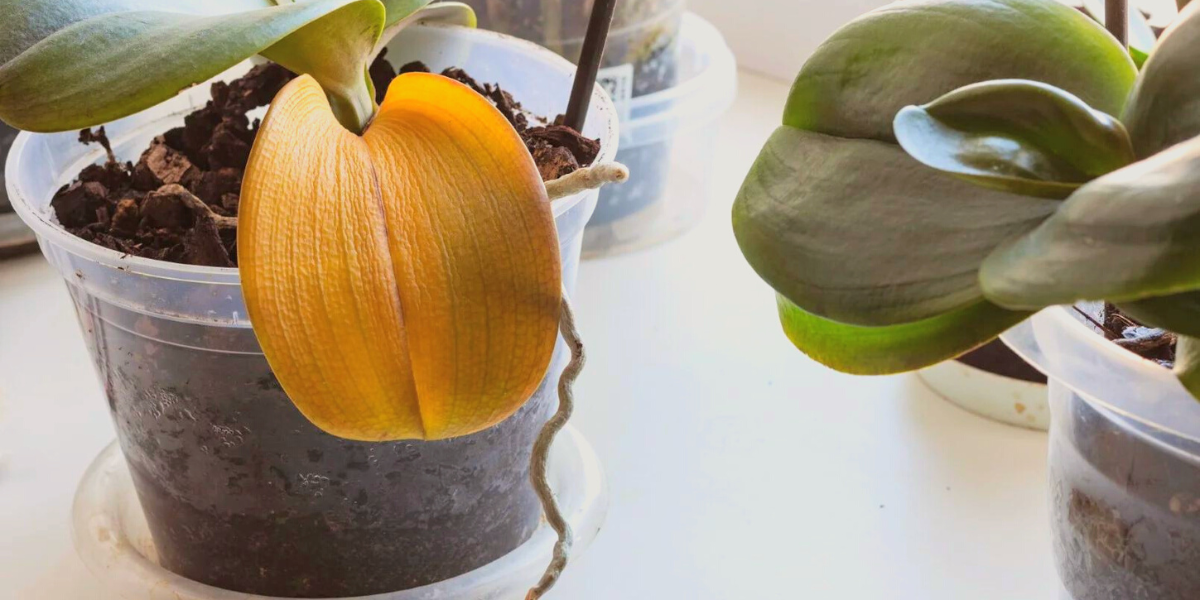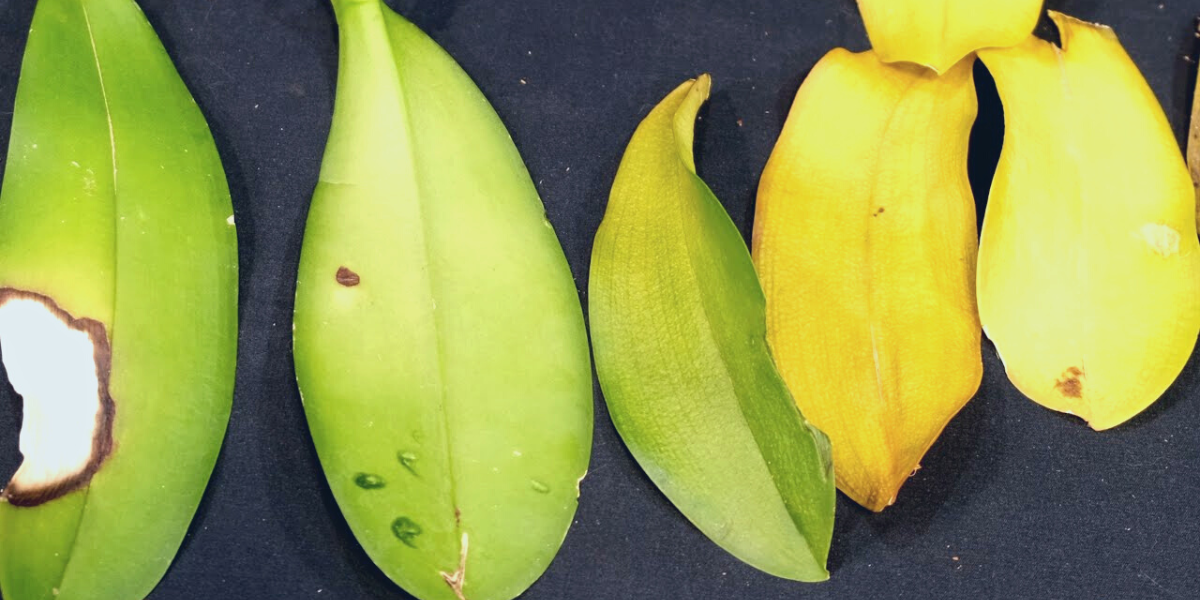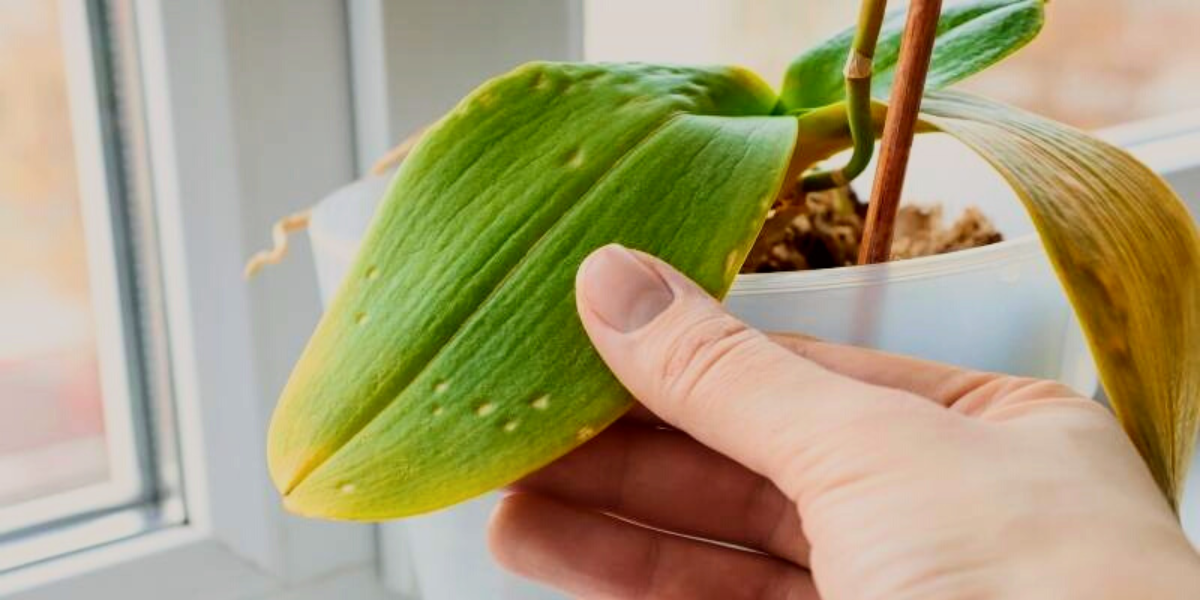An exotic and magnificent orchid is the dream of many growers. However, when buying or receiving such a flower as a gift, some inexperienced owners quickly destroy it, watering it like all other houseplants. Because of it, orchids got the title of difficult plants, which is not entirely true. It really cannot be called absolutely unpretentious, but subject to some simple care rules, it will be healthy and delight you with flowers all year round.
Disease conditions can manifest themselves in different ways. Most often, growers are faced with young orchid leaf turning yellow. This tropical flower is known for its dense dark green leaves, and when they change color, it should definitely be alarming. Let’s figure out what yellowing can be connected with, how to identify the root cause, and how to save your favorite plant from complete death.
Orchid Leaf Turning Yellow: Problem Overview
An orchid in perfect condition has green roots with a silvery or bluish patina, dense, elongated uniform green leaves with a vein in the center, and one or more long shoots with multi-colored flowers of different sizes. Most species grow in tropical latitudes, with high precipitation and humidity levels. At the same time, unlike many other indoor plants, potted Orchids do not grow in the usual dense soil but in mixtures with the addition of bark, stones, perlite, moss, coarse sand, dried roots, and so on.

So, the main problems with yellowing leaves are that growers violate the usual care routine for orchids, treating them like any other flowers. It may be due to a lack of knowledge or inattention. Thus, we can distinguish the following reasons that orchid leaf turning yellow:
- Overwatering. It is the main cause of all the problems associated with the health of orchids. In their natural environment, they grow, so the roots are not constantly in the water. Therefore, excessive watering, typical for many other types, can lead to yellowing of the leaves and the appearance of severe plant diseases like root rot.
- Lack of water. If you water the orchid too carefully, this volume of liquid may not be enough for it to feed. Then some leaves gradually acquire a yellow tint.
Inappropriate humidity. The requirements of each type of orchid are different. As a rule, the level of moisture they need varies between 40% and 70%. Deviations in any direction, especially sharp ones, adversely affect the well-being of these plants. Besides, high humidity increases the risk of bacteria and mold growth. - Low or high temperature. Orchids are susceptible to sudden changes in temperature and drafts. Even a few hours in the cold or, conversely, heat can lead to a deterioration in their health and yellowing of the leaves. Ideally, the room temperature should hover around 60-75°F.
- Problems with lighting. Many tropical plants like diffused light; orchids are no exception. They do better in the shade than in a well-lit area. At the same time, the lack of light adversely affects their normal development. If direct sunlight causes burns, the lack of light leads to yellowing of the leaves and weakening of the flower.
- Weather changes. All experts note that when the seasons change, and with them, the weather and environmental conditions, all these affect the orchids’ health. It is important to notice such changes on time and adjust your care routine accordingly.
- Lack of nutrients. Orchids like fertilizer. With their use, flowering becomes more active. Suppose you do not apply them (and adhere to an improper watering regime). In that case, it can lead to a gradual deterioration in health, an inability to resist diseases, yellowing of the leaves, and lacking buds.
- Bacteria and fungus. The consequence of improper watering, lighting, and humidity levels are serious diseases caused by bacteria and fungi. Damaged parts of orchids turn yellow and quickly die off. If not treated on time, the whole plant may die.
- Pests. Small insects are able to suck out beneficial juices from orchids quickly. Because of their activity, the orchid loses its strength, turns yellow, and withers.
- Aging. Don’t worry about your flower if you notice that the old orchid leaf is turning yellow. It is a completely natural process when old leaves die off, giving their nutrition to new shoots.
Yellowing of orchid leaves can be caused by both natural processes and wrong routines and diseases. It is essential to evaluate not only this single symptom but also look for other signs of a plant not feeling well to understand what caused this condition. Otherwise, the disease will quickly be transmitted to neighboring flowers in advanced stages.
Yellow Leaf on Orchid: Disease Symptoms and Diagnosis
Of all the reasons for orchid leaf turning yellow described above, only aging does not require you to take any active action. Just wait until the damaged leaf is completely yellow and dry. Then, you can easily separate it from the trunk. All other problems can be much more severe, so you should carefully examine the plant in search of other symptoms that could indicate a specific disease.

Overwatering and low temperature
If you overwater your orchid and keep it in a cool or drafty place, you can kill it pretty quickly. To understand what you do wrong, look at the roots. Luckily, these plants are usually grown in clear pots, so you don’t have to take them out. If the roots have acquired a whitish or yellowish tint, it means they have been in the water for too long. If they have darkened (turned brown or black), it is a signal that rotting processes have begun in the lower part. In this case, an unpleasant odor comes from the roots, and when you try to pull the plant out of the pot, the roots are easily separated. At the same time, the upper part dries, and a yellow leaf on orchid appears.
Underwatering and heat
The lack of moisture also negatively affects the well-being and appearance of this tropical plant. The leaves not only turn yellow but rather quickly lose their shape and wrinkle. The roots become light brown or gray, indicating that they have dried out. With a lack of moisture, the orchid blooms less often, and the buds themselves do not grow as large as under normal conditions.
Season changes
Changes in the orchid health associated with weather shifts have the same symptoms described in the two previous paragraphs. Remember that this plant reacts extremely negatively to sudden environmental changes. So you need to be attentive to such signals.
High humidity
Although orchids love moisture and do well when sprayed, you should not exceed the allowable humidity limits. The fact is that a wet pot and roots are an excellent environment for the development of associated yellow leaf disease, bacteria, and fungi. If a whitish coating has formed on the roots, topsoil, stem, or back of the leaves, you need to reduce the humidity in the room.
Wrong lighting
Sunburns usually have no secondary symptoms. If you don’t move the orchid’s pot elsewhere, you’ll notice that the lesions grow and more and more parts of the plant turn yellow. The flower develops very slowly in low light, and some leaves may darken and then turn yellow.
Nutrient deficiency
Orchids usually grow in a special mixture, where there is practically no soil filled with useful elements. That is why they need fertilizers that stimulate development. If, in addition to orchid leaf turning yellow, you find that your flower does not produce new leaves, little or no flowering, while no other signals like pests or fungus, then it is probably lacking in nutrients.
Bacteria and fungus
Such organisms can manifest themselves in different ways. Bacteria usually stimulate decay processes inside and on the surface of plants. Therefore, the symptoms of bacterial diseases are similar to root rot. On the other hand, fungi look like a coating of white, gray, or yellowish hues on various parts of the plant. The most common problems are anthracnose, powdery mildew, plant rust, and gray mold.
Pests
Since orchids do not grow in the usual soil, many pests do not start on it because they have nowhere to “live.” However, even these plants sometimes suffer from insect infestations and need pest control actions. These can be whiteflies, scales, mites, mealybugs, thrips, and aphids. You will find groups of these pests on the back of the leaves, at their junctions, young shoots, and inflorescences. A distinctive feature of many of these insects is that they leave behind a sticky mass called honeydew.

In order not to waste time in vain and not to make a mistake in classifying the problem, it is best to use the mobile application:
- To assess the condition of your orchid from all sides, it is advisable to get it out from the pot and carefully try to remove pieces of bark from the roots. Place the plant in a well-lit area so that all damage is visible.
- Take a picture of the whole orchid and those leaves, roots, and flower stalks that seem unhealthy to you.
- The system will analyze the information in the images and offer you the most likely orchid diseases.
With this knowledge, you can begin to solve the problem.
Treatment for Yellow Spots on Orchid Leaves
As you can see, the appearance of yellowing leaves or yellow spots on orchids can indicate various problems. Of course, the ways to solve them are also different:
- Overwatering. Although it affects the appearance of the flower, in the early stages, you may well save the plant. Remove it from the pot, being careful not to damage the roots (they are extremely fragile in orchids), and let it dry thoroughly. After that, repot it into a new soil mixture.
- Root rot. It is a difficult stage, which is a consequence of the previous point. You need to take the plant out of the pot and completely remove all brown and black areas. The remaining parts should be treated with a fungicide to stop the disease cycle. Cuts should be sprinkled with crushed activated charcoal. Leave the processed orchid in the fresh air until it is completely dry, and then repot.
- Underwatering. Pull the dried flower out of the pot and cut off all the dead parts: roots, leaves, and stalks. After that, “bathe” it in water and watch the roots. If they begin to acquire a greenish tint, they are alive. You can put the plant in a pot and normalize irrigation. If the color of the roots has not changed, the orchid, unfortunately, has died.
- Change of season. Always adjust your care routine as the weather changes. In summer, plants should be watered, bathed, and sprayed more often. In winter, excessive moisture should be avoided.
- Burns. Unfortunately, it is impossible to cure burns on orchids. The leaves will remain damaged until they dry completely. In any case, move the flower to a dark place.
- Lack of light. Orchids thrive best on the south side, so place them on a window that faces that side. If it is impossible, use artificial lighting.
- Lack of nutrients. This tropical flower loves fertilizer. You can choose ready-made solutions in the store or make your own natural remedy. In addition to the main NPK complex, the mixture should contain iron, magnesium, manganese, calcium, and sulfur. A diseased plant should be fed only after it releases a new leaf.
- Fungus and bacteria. These problems need to be dealt with when it comes to fungicides. Natural treatments such as neem oil, diatomaceous earth, and soda-alcohol sprays work well for such ailments.
- Pests. Try to remove most of the insects manually, using a cotton swab and a soap-alcohol solution. Then treat all parts of the plant with an insecticide. Repeat applications until the entire pest colony dies.
To avoid fighting the orchid leaf turning yellow again, you should adhere to the correct care of orchids. Remember that it is better not to water them like ordinary plants but to bathe them by immersing the pot in water for half an hour. Try to keep the humidity around 40-70%, but do not let the liquid get into the rosettes of the leaves. The room temperature should be around 60-75°F with the pot out of drafts and direct sunlight. When repotting, try to pick a container of the correct size. Orchids do not do well in large pots.
Leave a Reply
You must be logged in to post a comment.